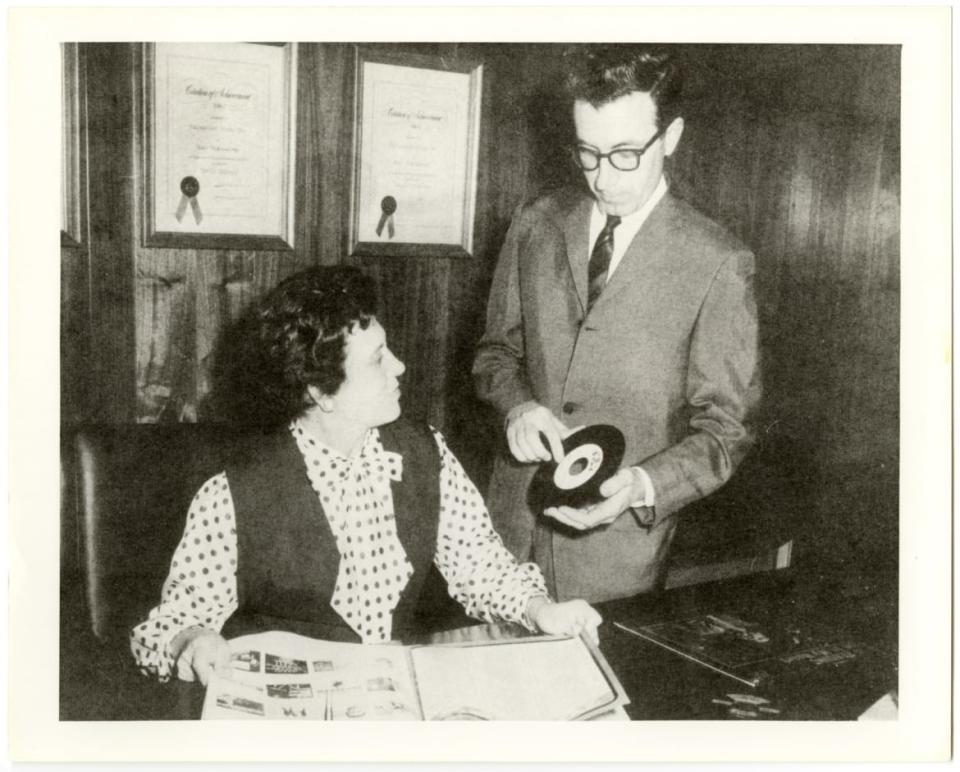The Iconic Memphis Label Behind Music’s Most Soulful Stars

“We were flying by the seat of our pants,” Stax legend William Bell recently recalled of the early days of the venerable label that tracked the rise of the civil rights movement. “A lot of us came in from the gospel arena, right out of church, just neighborhood kids. We learned how to craft a song as young kids, 14, 15 years old, but really, we just wanted to hear our voices on the radio.”
According to legend, Stax Records replaced cotton as the single biggest product coming out of Memphis, Tennessee, during its late-1960s heyday. And if you know the Stax story, it’s not hard to believe.
But if you only know the hits, and not the rags-to-riches tale of the label that made stars of Otis Redding, Isaac Hayes, Sam & Dave, the Staple Singers, and so many more, then you couldn’t do better than STAX: Soulsville U.S.A., a four-part documentary that premieres on Max on May 20 and tracks its remarkable, and often heartbreaking, history.
The TV Premiere Audience Award winner at this year’s SXSW Film & TV Festival, STAX: Soulsville U.S.A. is produced and directed by Jamila Wignot, and features firsthand accounts from just about every living artist and executive associated with the label, along with a striking collection of restored and remastered performance footage. Wignot’s series details everything from Stax’s remarkable early successes to what amounted to a “hostile takeover” by Atlantic Records, plus its rise from the ashes under the direction of Al Bell, which hit its apex when Stax artists commemorated the Watts Rebellion by playing to an almost all-Black audience of over 100,000 at the 1972 benefit concert Wattstax.
“When I walked into the first meeting about the project, they asked me, ‘What do you think about making a film about Stax?’ I was shocked and said, ‘Look who’s on my phone right now!’ because I was listening to Otis Redding on the way there,” Wignot tells The Daily Beast.
“In the beginning,” the director continues, “I really thought I was going to have this amazing opportunity to get into the catalog and get access to all of the recorded music. And all of that absolutely happened, which was brilliant. But what I was not as aware of was the incredible success and tragedy.”
In just over 15 years, Stax grew from a modest, family-owned record store and studio in Memphis to a trailblazing global music label. STAX: Soulsville U.S.A. chronicles the audacious group of individuals—chief among them founders Jim Stewart and Estelle Axton (the ST and AX in Stax), former radio promoter-turned-visionary executive Al Bell, and artists like Hayes, David Porter, and William Bell—who smashed racial barriers and left an enduring musical legacy in their wake.

Estelle Axton, Jim Stewart
“As Jim Stewart put it, when ‘Green Onions’ [by Booker T. & the MG’s] became a hit, ‘The light went on in my brain. Forget country. I’m not getting anywhere with that. This music is magic,’” Rob Bowman, author of the exhaustive history of the Stax label, explains. “And you can say that, cynically, it was magic because it made him money and Atlantic Records picked up distribution. But he also loved that music so much that, several years later, an engineer was arguing with Jim about a song and said, ‘Look, if we put a bridge in here, we’ll be able to appeal to the pop market.’ Jim told me that he said, ‘I don’t give a good goddamn if we sell a record to another white person. This is what we make.’ So Jim and Estelle Axton were very progressive people for Memphis, especially in the early ’60s.”
The Stax story isn’t just a story about hit records, though they were, of course, in abundant supply. “Green Onions,” “I’ve Been Loving You Too Long,” “Hold On! I’m a Comin’,” “Knock On Wood,” “Try a Little Tenderness,” “Soul Man,” “Who’s Making Love,” “Walk on By,” ”Mr. Big Stuff,” “Respect Yourself,” and, most of all, “[Sittin’ on] the Dock of the Bay” are ample evidence that Stax is rightly heralded as one of the great labels of the Golden Age of music. In fact, during its 15 years in business, Stax released more than 800 singles and nearly 300 LPs, winning eight Grammys and one Academy Award. The label placed more than 167 songs on the Top 100 pop charts, and an almost unbelievable 243 on the Top 100 R&B charts. But as impressive as those statistics are, they’re only part of the story.
From its earliest days, Stax was an oasis in the heart of the Deep South. At a time when too many Southern whites were holding on to bitter, racist values—when Black people and white people in Memphis would hardly ever socialize, let alone sit and eat or ride the bus together—Stax was different. When you walked inside the old theater on McLemore Avenue that had been converted into a recording studio and offices, you became an equal amongst your peers.
As one of the truly great artists of Stax, William Bell recalls that, Black or white, you were judged on the quality of your work, your commitment to your craft, and nothing else.
“People like Jerry Lee Lewis and Elvis, they didn’t care, we didn’t care, we would jam at the same club. And so we knew everybody, because most of us lived within a three-mile radius of each other. It was a gumbo. A grassroots gumbo,” Bell recalls. “We came right out of church, or right from the cotton fields, and we brought that element into the music. Motown wanted to cross over, so they polished their acts up and put them in schools for all that stuff, and it worked for them. But it worked for us also, because we were the working man’s label.”
There were no better ambassadors of that ethos in Stax’s earliest days than Booker T. & The MG’s. Whether the MG in the band’s name stood for Memphis Group or Mixed Group, the message the band sent, via both its soul and R&B-infused sound and its multiracial make-up, was powerful. With Booker T. Jones on Hammond organ and Al Jackson Jr. on drums, plus Donald “Duck” Dunn on bass and Steve Cropper on guitar, the mix of Black and white players—who would scrape the top of the charts with their very first release, and who would go on to become the house band at Stax behind some of its best-loved songs—they represented everything Stax stood for: great music and an artistic brotherhood between like-minded souls, ahead of anything else.
Ringo Starr Says the Beatles’ ‘Let It Be’ Film Had ‘No Real Joy’—Until Now
But for Stewart and Axton, the money they made from Booker T. & The MG’s hits was of more pressing consequence. It kept the label running, until the day a tall, handsome roadie walked through the door and changed Stax’s fortunes forever.

STAX Records
Otis Redding was a star of the first order. From the day he ambled into Stax carrying Johnny Jenkins’ left-handed guitar—and pestered Cropper and Stewart to listen to him sing, delivering a spine-tingling rendition of “These Arms of Mine” at the end of Jenkins’ session—until his tragic death in a plane crash in December 1967, the charming singer scored hit after hit. In doing so, he sealed his status as one of the greatest singers of all time, and helped establish Stax as the gritty antidote to Detroit’s sweet Motown sound; the Soulsville to Motown’s Hitsville.
“Otis Redding is the most important artist in the first period of Stax, and was instrumental in determining the Stax sound,” Bowman says. “It’s hard to think of a better soul singer. And it was Otis who came up with the idea of horn ensemble lines. There are no background vocalists on those Stax records in the sixties; the horns served that role.”
“I’ve Been Loving You Too Long,” “Try a Little Tenderness,” “Tramp,” with star labelmate Carla Thomas, and, posthumously, the aching folk-soul classic “(Sittin’ on) the Dock of the Bay” provide almost the perfect overview of Redding’s meteoric career, and are proof positive of his everlasting influence.
When Otis Redding Delivered the 20 Best Minutes of Pop Music Ever
Those songs also encapsulate the label as the soundtrack of the burgeoning civil rights movement and the unrest that soon followed. As William Bell recalls, it was an ethos the Stax artists lived and breathed.
“People started to realize, once you get past the color thing, there’s not that much difference between us because we’re all human,” he says. “So we made a difference in Memphis, and then traveling around. We were all determined that we were not going to be bullied.”
Perhaps more than any of the artists in the first wave of Stax stars, the Staple Singers personify all that the label has come to represent in the years since its doors first swung open. The group had enjoyed success with gospel spirituals since the mid-1950s, but it was with Stax that the Staple Singers found their collective voice. At the height of the civil rights movement, they cast that message of peace, love, and brotherhood to a broader audience, introducing the idea of Black empowerment through their music.
If you only know the Staple Singers’ cover of The Band’s “The Weight,” that’s just the tip of the iceberg. “Heavy Makes You Happy (Sh-Na-Boom-Boom),” “Respect Yourself,” “I’ll Take You There,” and “If You’re Ready (Come Go With Me),” all released in the wake of Dr. Martin Luther King Jr.’s death, marked the ascendance of “message music” and a turning point in Stax’s history. These were not just songs made to sound good on the radio. Instead, they were songs with heart, soul, and meaning for the world at large. The group’s mix of Southern gospel, topical folk, deep soul, R&B, and even pop is a melting pot of music unlike any that came before or even that we have experienced since. It also paved the way forward for Stax—while the label’s story in the 1960s tracks the movement for equality, in the 1970s it came to represent the advancement of Black empowerment.
In the end, however, Stax became a victim of its own success, struggling to balance its books while enjoying unprecedented expansion. During an era of tremendous social turmoil, systemic inequity, and racial tensions, Stax, an integrated company, saw stunning artistic and cultural success, and managed to rebound from repeated business setbacks and tragic losses before the studio ultimately dissolved after 15 pioneering years. But as STAX: Soulsville U.S.A. shows, its legacy—the music recorded under the Stax banner, as well as the underlying message of freedom, equality, and self-empowerment—lives on, and speaks just as powerfully to today’s troubled times.
“I think the people at Stax wanted [equality] as much as we, as a nation, wanted it,” Wignot says. “We want someplace where social tensions and problems can fade away into something much more beautiful. Booker T. says, ‘We were a family, and families lie to themselves. We lie to ourselves, we lie to other people, and we had a great time doing it. But [that inequality] was there nonetheless.’ The Stax story is wonderfully complex, and so much a mirror of who we are right now, and who we have been as a country.”
Get the Daily Beast's biggest scoops and scandals delivered right to your inbox. Sign up now.
Stay informed and gain unlimited access to the Daily Beast's unmatched reporting. Subscribe now.


